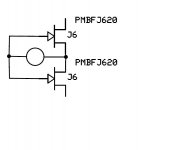Uploading would be great. I only have hardcopy. At least the oscillator page.
It's a big manual. How much of it do you want up there?
Just the OSC?
Thats the key page. The FET is used for fast settling and when it has settled it switches to LDR. It would be interesting to swap a Silonex LDR in to one and see if it makes a difference. John Curl was getting very low THD from an ST1700. Unfortunately they are all getting old and flakey. On that note things like the QA400 will replace most of this stuff soon.
John -- can you make those into a PDF and zip it, so we can download the whole thing at once?
That app note is on the web anyway:
http://s.eeweb.com/members/earl_albin/answers/1355009286-vcr.pdf
Samuel
That app note is on the web anyway:
http://s.eeweb.com/members/earl_albin/answers/1355009286-vcr.pdf
Samuel
Hi Samuel,
We know about that one. The one posted by John is the original Siliconix An73-1
Covers a bit more detail.
Cheers,
John -- can you make those into a PDF and zip it, so we can download the whole thing at once?
In three parts due to file size limits - I didn't want to reduce image quality.
Attachments
The subject is also covered in Siliconix's 1981 book "Designing with Field Effect Transistors". McGrawHill -RNM
Last edited:
Take a look at CR14 peak detector. Hanging a diode off the prestine sinewave? What small amount (H2?) does it contribute?
[needs to be buffered?] -RNM
[needs to be buffered?] -RNM
I'm going to order one of those opto photovoltaic cells. I think this would be ideal for fig 19.
in the an73-1.
I believe SW already suggested this some posts ago.
Cheers,
in the an73-1.
I believe SW already suggested this some posts ago.
Cheers,
What applications would they be for -- high Vp devices? So, I can go to that type to find possible suitable jFET. Thx - RNMarshNo, I think a better statement is that the FET wants to stay in the triode region well away from Vp. What you want is very high Vp which happens in general to go with long channels. The down side is that high Vp low Idss FET's are higher resistance and it's harder to make them be just a small portion of the feedback mechanism. The linearization tries to keep the FET looking like a resistor centered on the origin rather than off to one side, hence the trim tweaks the seconds. This trick is very old BTW well known when I started in 1973.
What applications would they be for -- high Vp devices? So, I can go to that type to find possible suitable jFET. Thx - RNMarsh
RF
Take a look at CR14 peak detector. Hanging a diode off the prestine sinewave? What small amount (H2?) does it contribute?
[needs to be buffered?] -RNM
I've tried buffing this and it didn't seem to have any effect. But it wouldn't hurt to have a second look.
I'm going to order one of those opto photovoltaic cells. I think this would be ideal for fig 19.
in the an73-1.
I believe SW already suggested this some posts ago.
Cheers,
Yes indeed, perfect application. I will gladly answer any questions should they arise. I think the Panasonic ones are cheap and widely stocked and easily make enough volts for any Vp.
can you suggest a source and model number (approx 50-100 ohms)? Thx-RNMarshYes indeed, perfect application. I will gladly answer any questions should they arise. I think the Panasonic ones are cheap and widely stocked and easily make enough volts for any Vp.
I think he is referring to optocouplers that generate a voltage out from a voltage in. The idea is to drive the Jfet gate from a floating source tied to a pair of resistors in series across the source-drain of the resistor.
I think he is referring to optocouplers that generate a voltage out from a voltage in. The idea is to drive the Jfet gate from a floating source tied to a pair of resistors in series across the source-drain of the resistor.
Yes this is it.
They can be had from Digikey and other suppliers.
These PV's don't have much of a output voltage range.
3V min and 8V max is typical. Not sure how to use these.
3V min and 8V max is typical. Not sure how to use these.
- Home
- Design & Build
- Equipment & Tools
- Low-distortion Audio-range Oscillator
